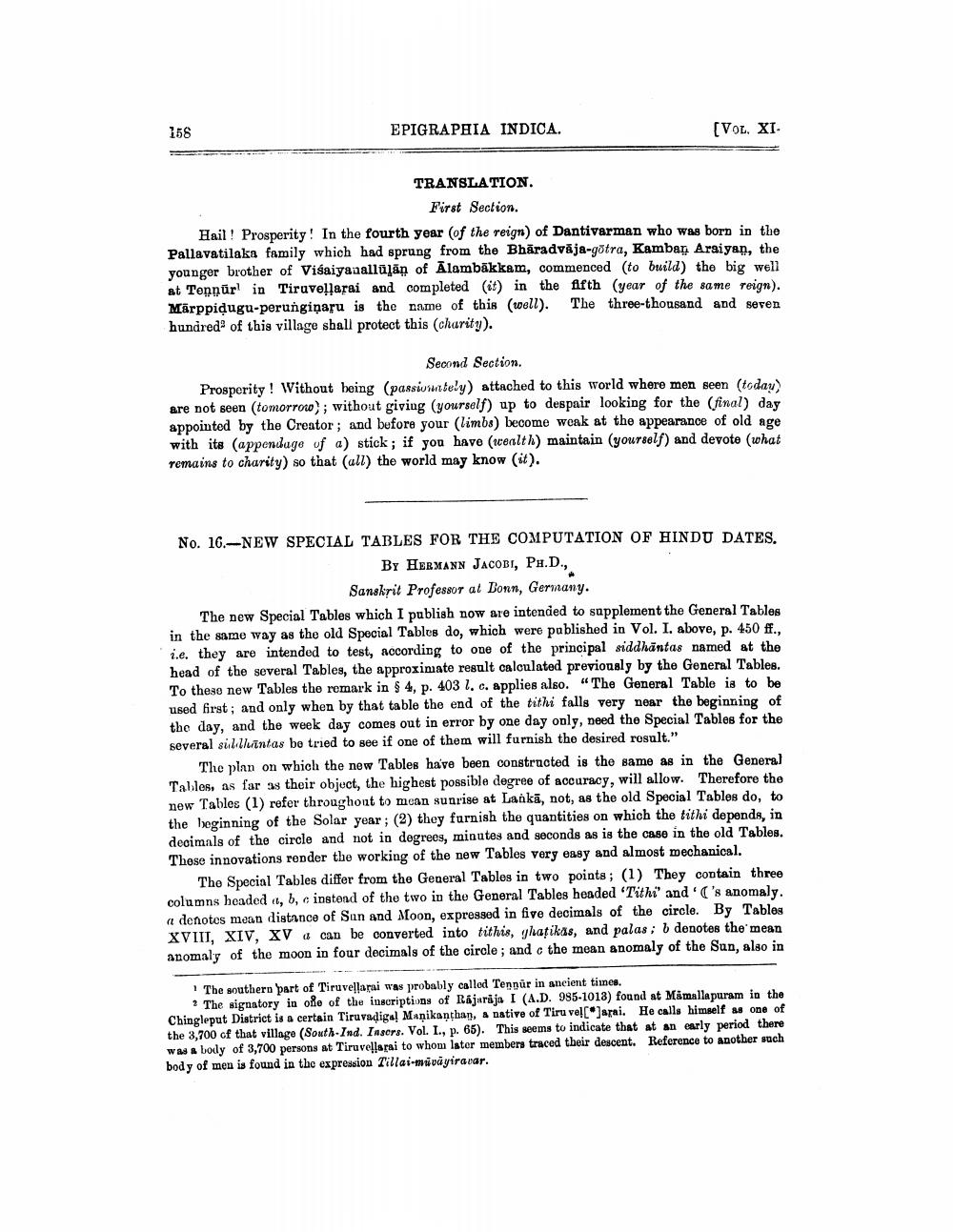________________
158
EPIGRAPHIA INDICA.
(VOL. XI.
TRANSLATION.
First Section. Hail! Prosperity! In the fourth year (of the reign) of Dantivarman who was born in the Pallavatilaka family which had sprung from the Bhāradvāja-gotra, Kambar Araiyan, the younger brother of Visaiyaaallujän of Alambakkam, commenced (to build) the big well at Tennürl in Tiruvellarai and completed (it) in the fifth (year of the same reign). Mārppidugu-perungiñaru is the name of this (well). The three-thousand and seren hundred of this village shall protect this charity).
Second Section. Prosperity ! Without being (passionately) attached to this world where men seen (today) are not seen (tomorrow); without giving (yourself) up to despair looking for the (final) day appointed by the Creator; and before your (limbs) become weak at the appearance of old age with its (appenduge of a) stick; if you have (wealth) maintain yourself) and devote (what remains to charity) so that (all) the world may know (it).
No. 16.-NEW SPECIAL TABLES FOR THE COMPUTATION OF HINDU DATES.
BY HERMANN JACOBI, PH.D.,
Sanskrit Professor at Donn, Germany. The new Special Tables which I publish now are intended to supplement the General Tables in the same way as the old Special Tablos do, which were published in Vol. I. above, p. 450 ff.. i.e. they are intended to test, according to one of the principal siddhāntas named at the head of the several Tables, the approximate result calculated previously by the General Tables. To these new Tables the remark in $4, p. 403 1. c. applies also. "The General Table is to be used first; and only when by that table the end of the tithi falls very near the beginning of the day, and the week day comes out in error by one day only, need the Special Tables for the several sillhlintas be tried to see if one of them will furnish the desired rosult."
The plan on which the new Tables have been constructed is the same as in the General Tables, as far as their object, the highest possible degree of accuracy, will allow. Therefore the new Tables (1) refer throughout to mean sunrise at Lankā, not, as the old Special Tables do, to the beginning of the Solar year; (2) they furnish the quantities on which the tithi depends, in decimals of the circle and not in degrees, minutes and seconds as is the case in the old Tables. Those innovations ronder the working of the new Tables very easy and almost mechanical.
The Special Tables differ from the General Tables in two points ; (1) They contain three columns headed, b, c instead of the two in the General Tables headed "Tithi' and '('s anomaly. a denotes mean distance of Sun and Moon, expressed in five decimals of the circle. By Tables XVIII, XIV, XV can be converted into tithis, yhatikas, and palas; b denotes the mean anomaly of the moon in four decimals of the circle; and c the mean anomaly of the Sun, also in
1 The southern part of Tiruvellarai was probably called Tennur in ancient times,
The signatory in ore of the inscriptions of Rájarija I (A.D. 985-1013) found at Mimallapuram in the Chingleput District is a certain Tiruvadiga Manikanthan, a native of Tiru ve!
C arai. He calls himself as one of the 3,700 of that village (South Ind. Insors. Vol. I, p. 65). This seems to indicate that at an early period there was a body of 3,700 persons at Tiruvellarai to whom later members traced their descent. Reference to another such body of men is found in the expression Tillai-mi vayiravar.




